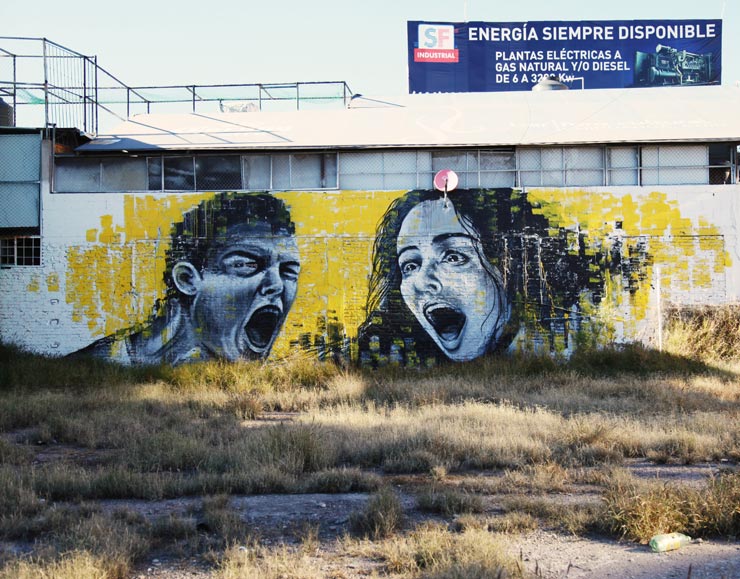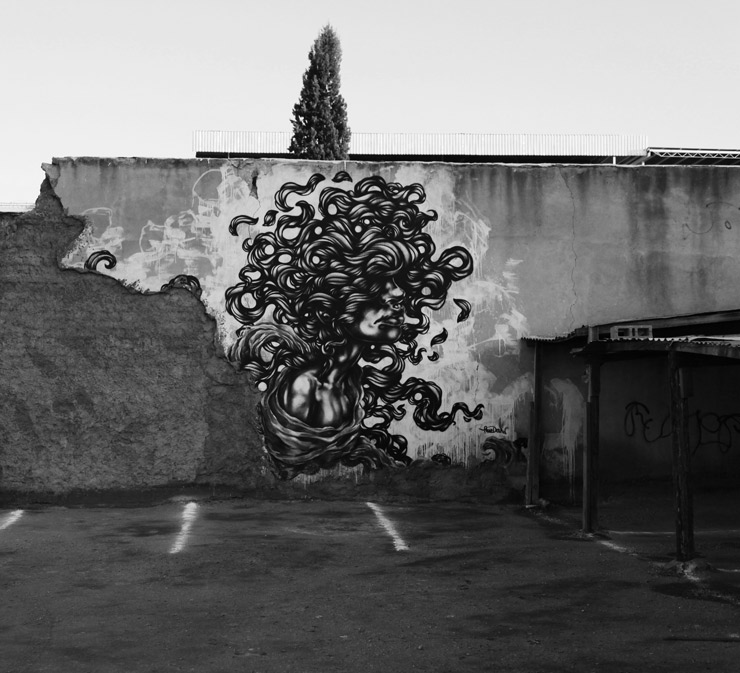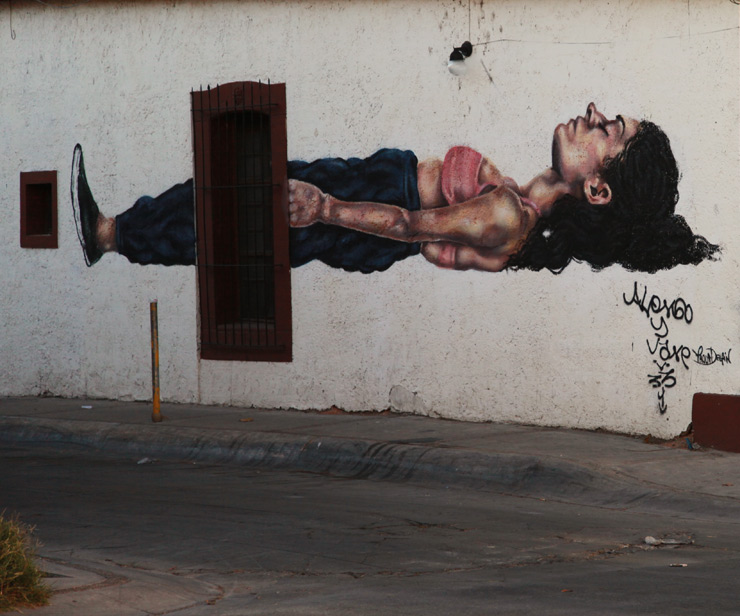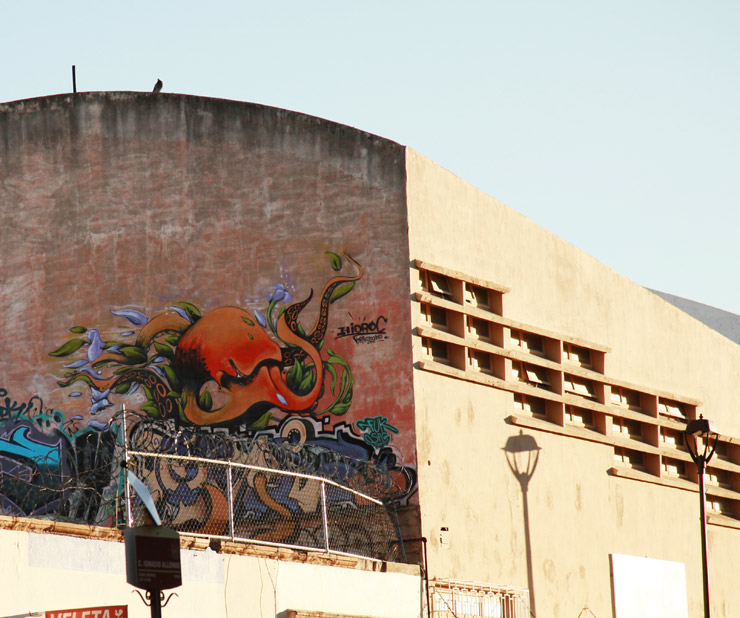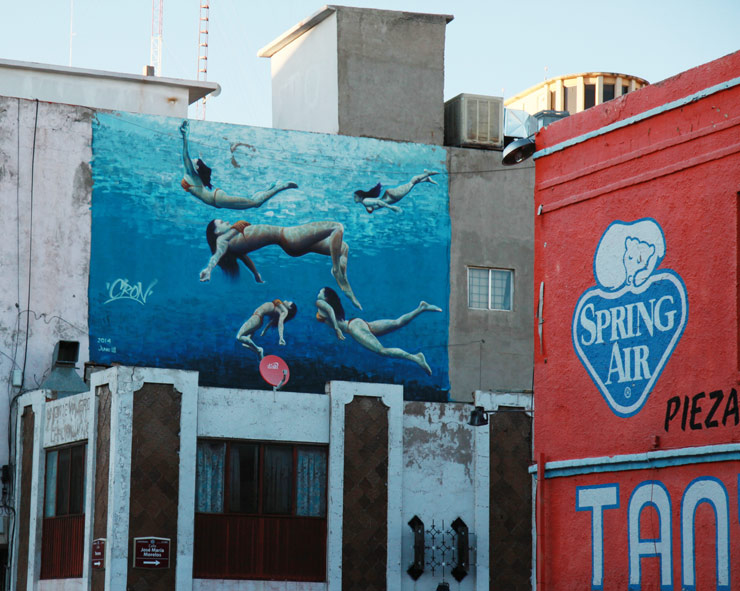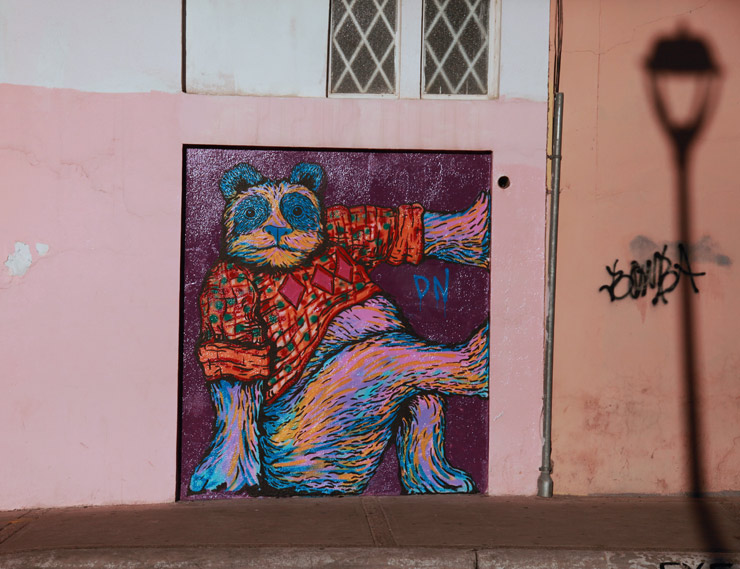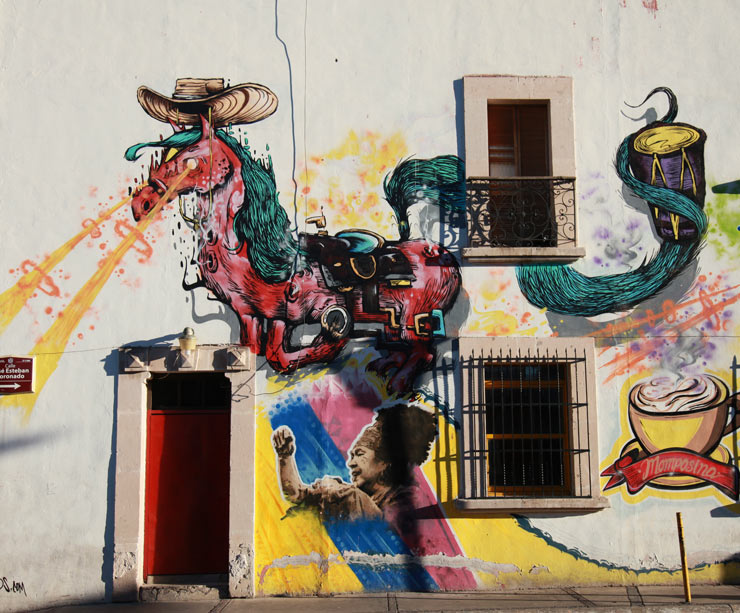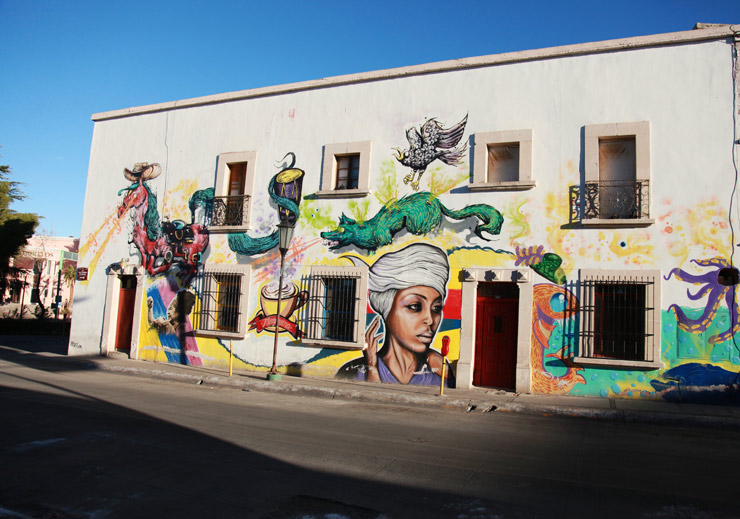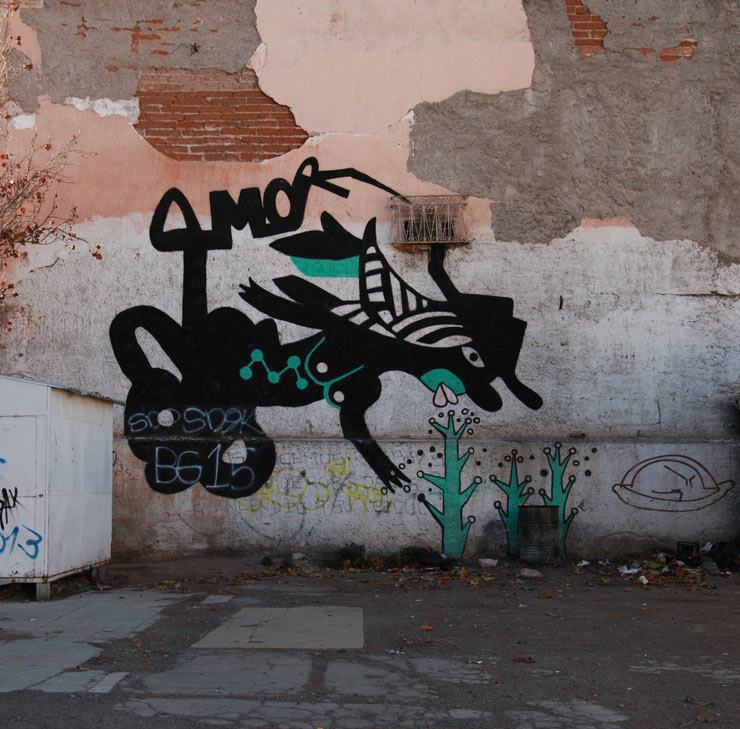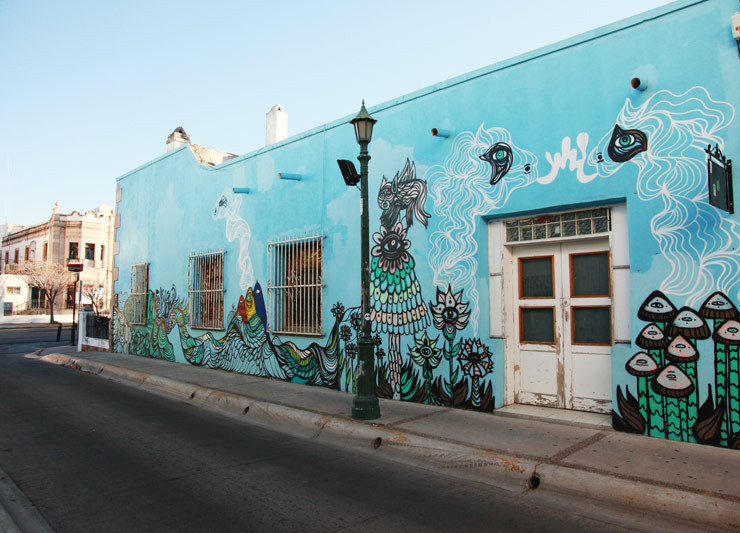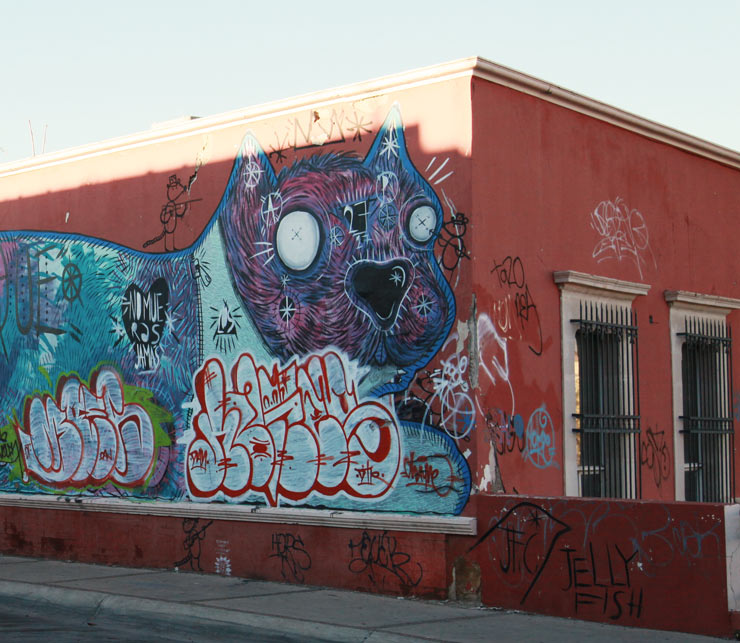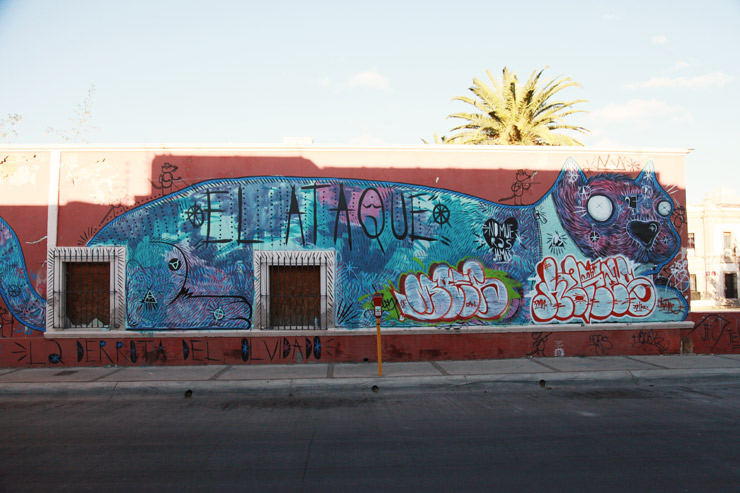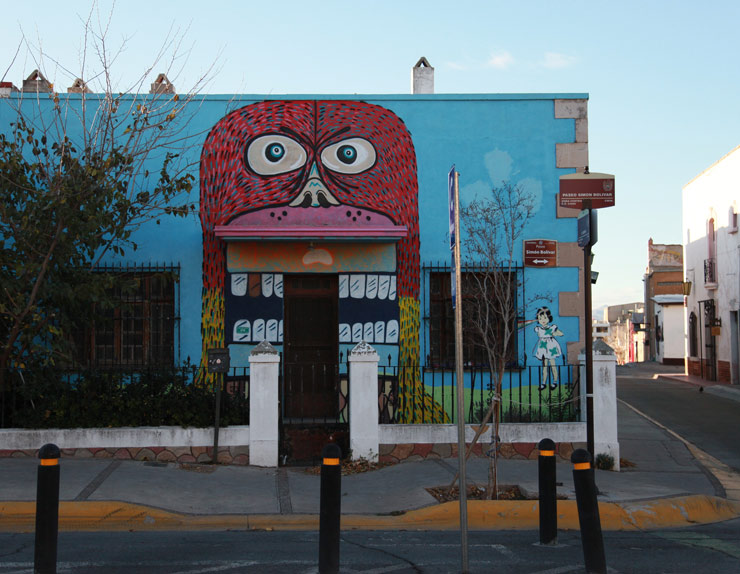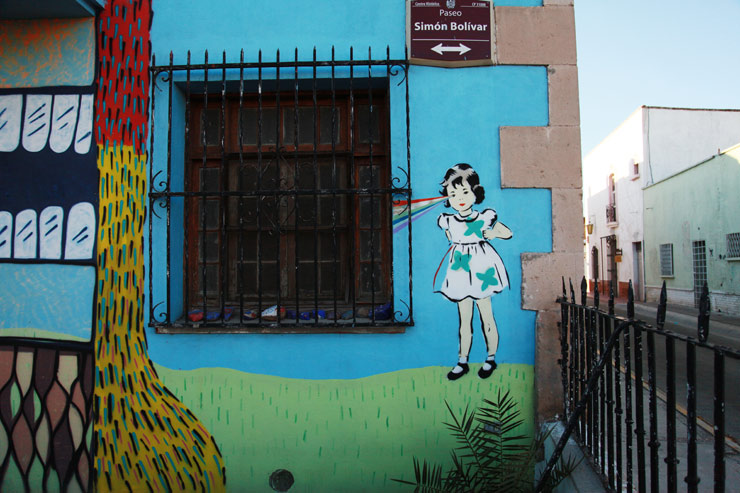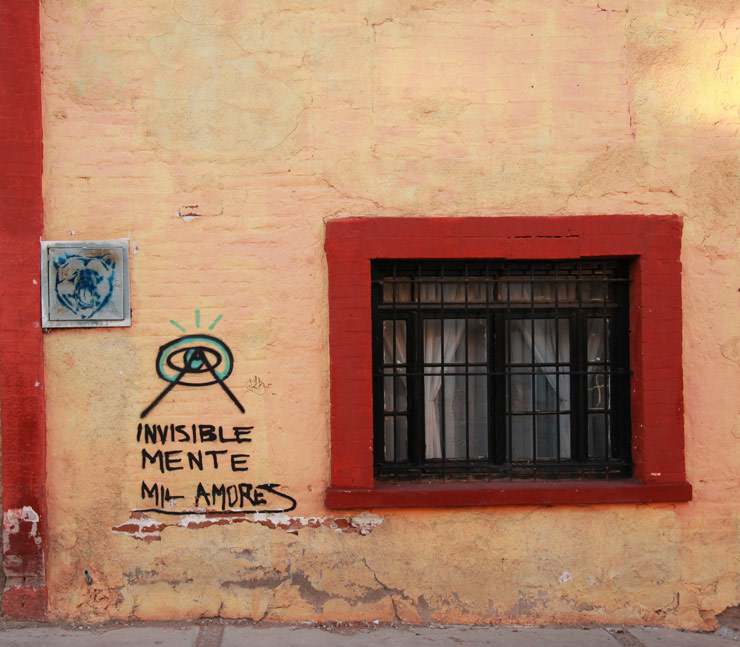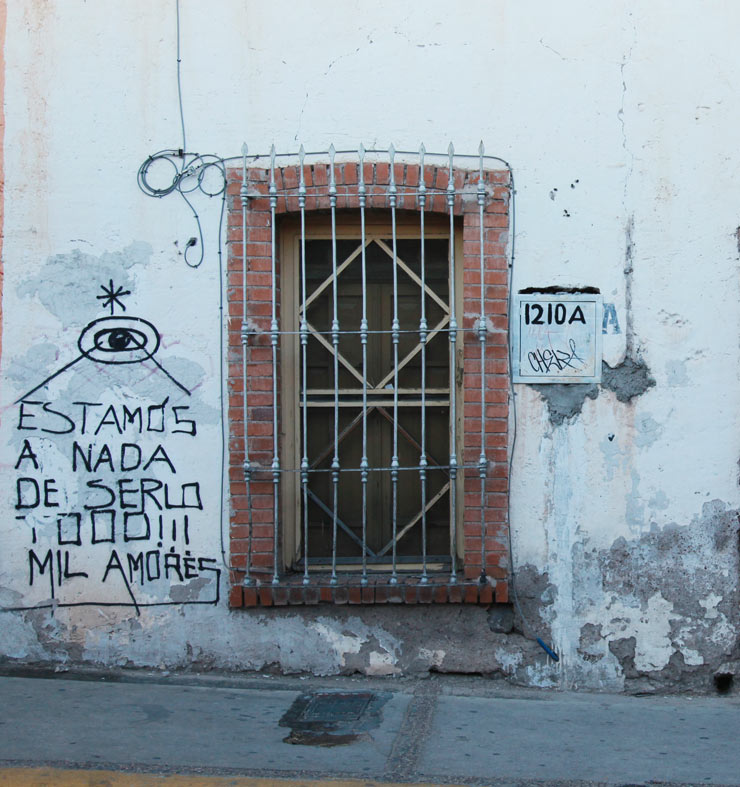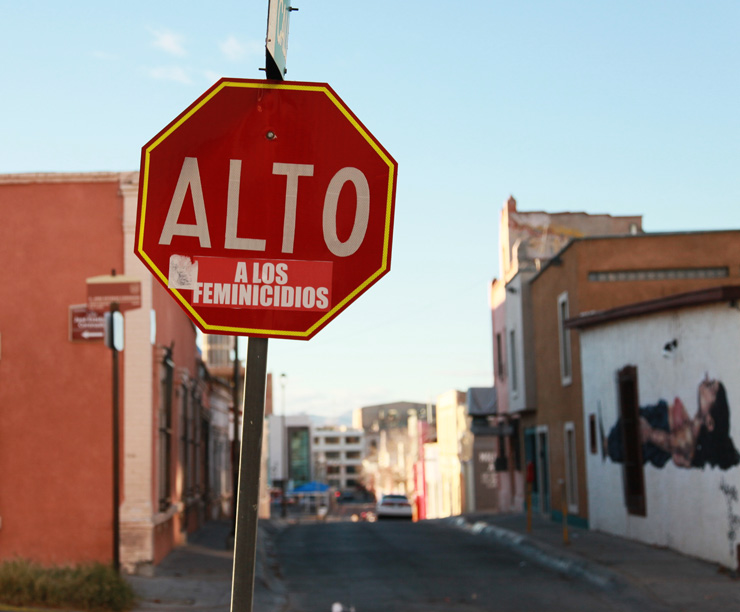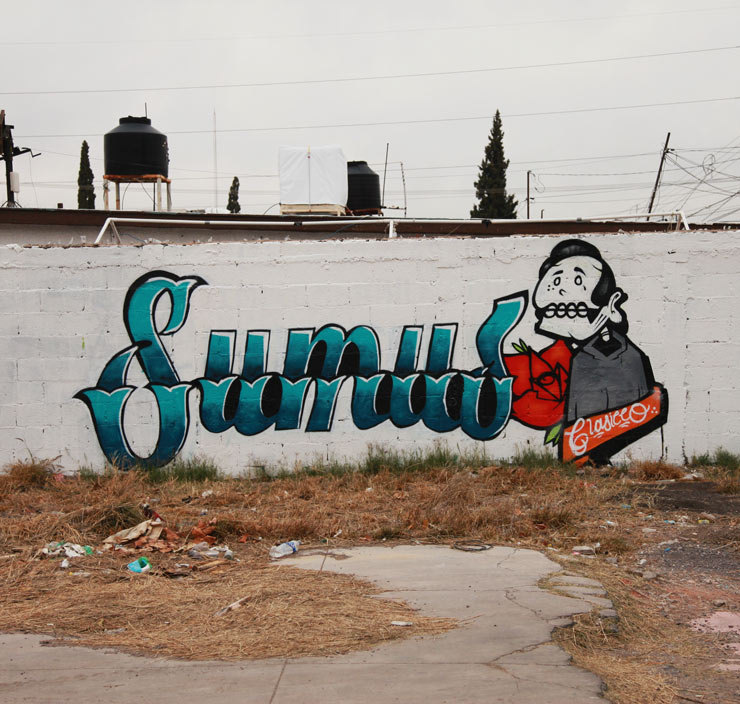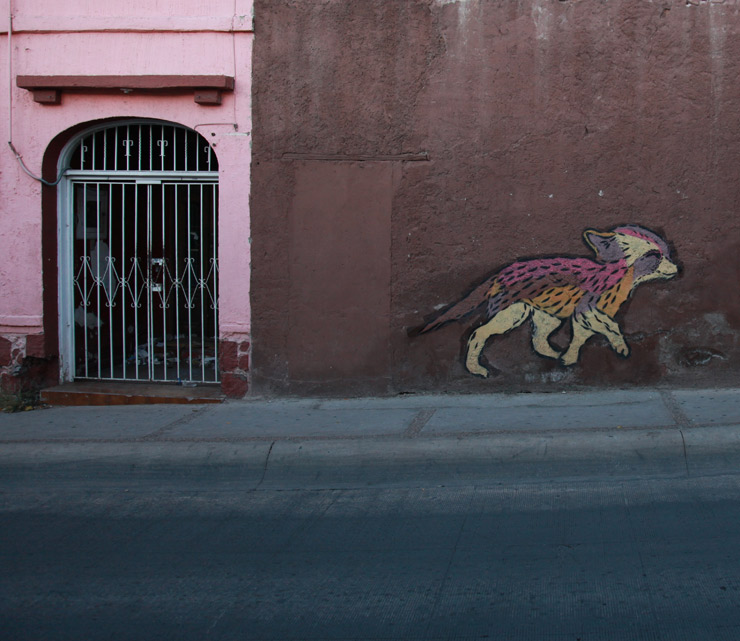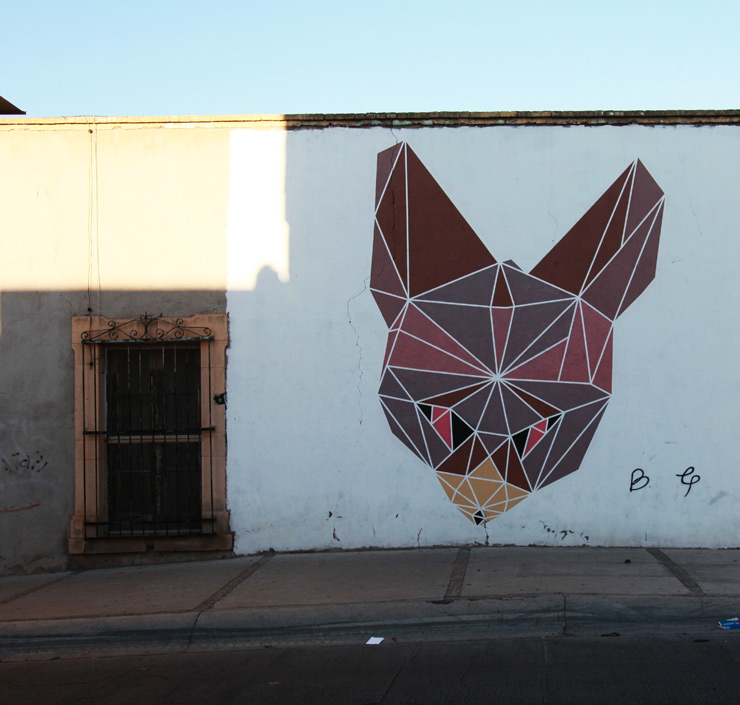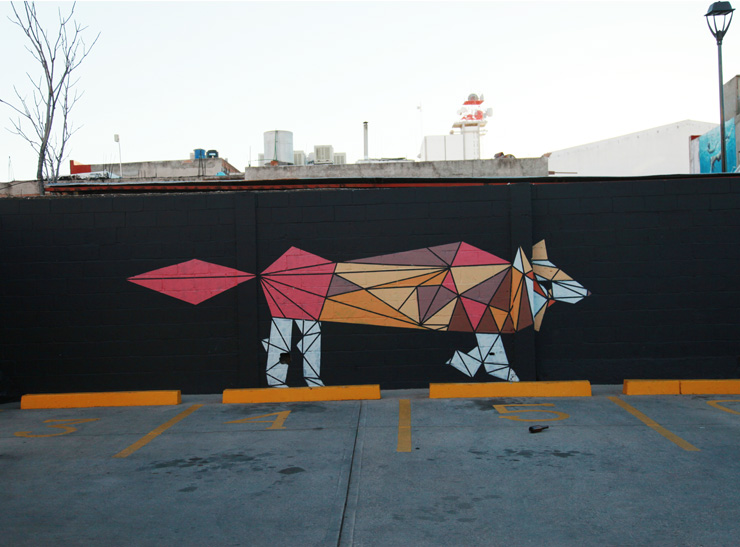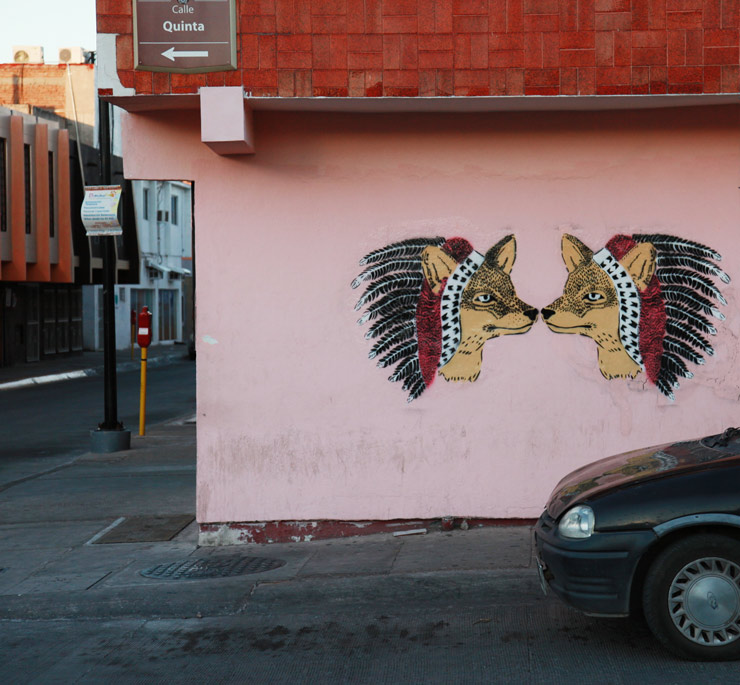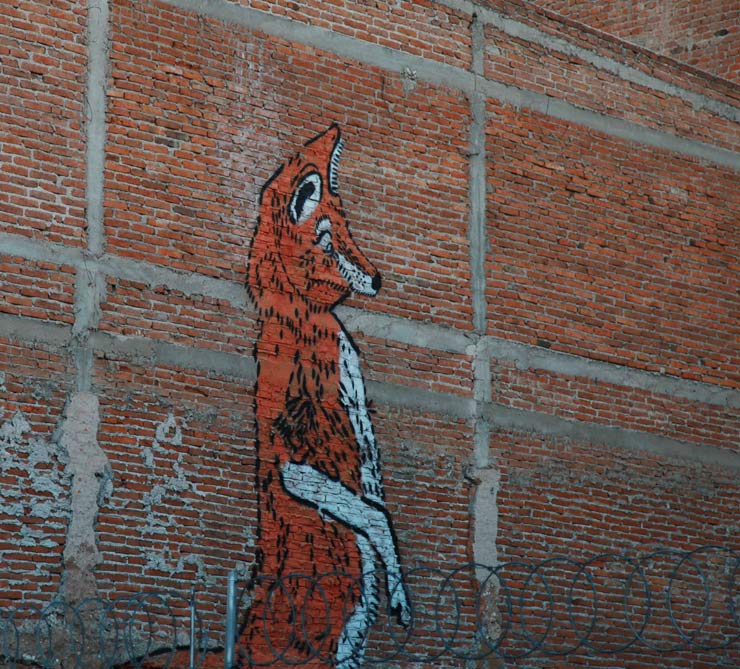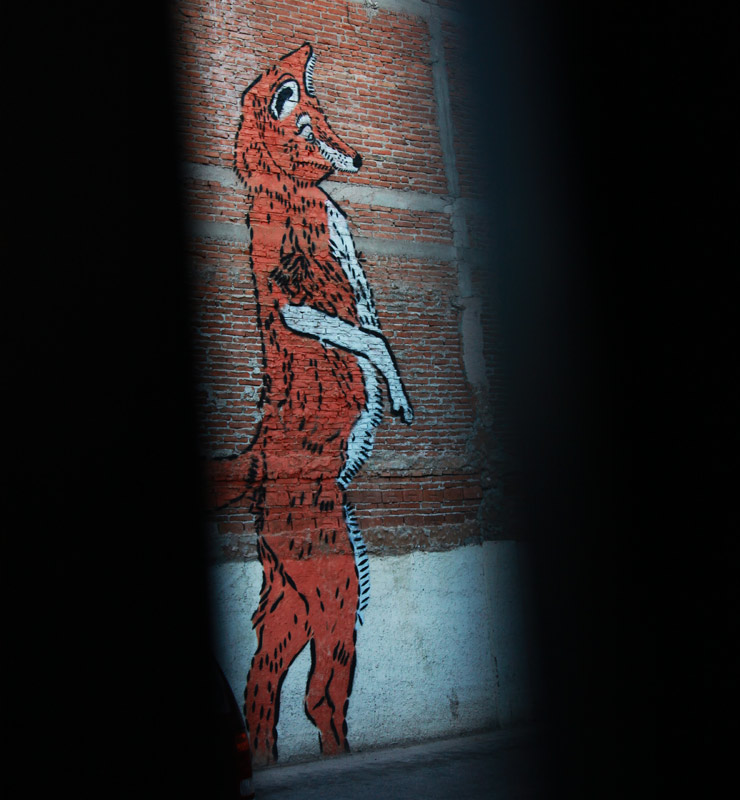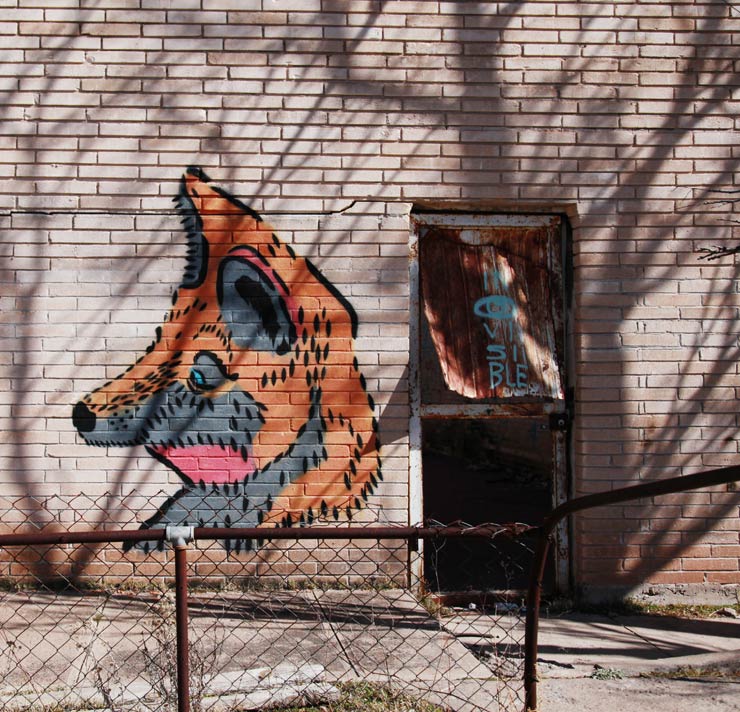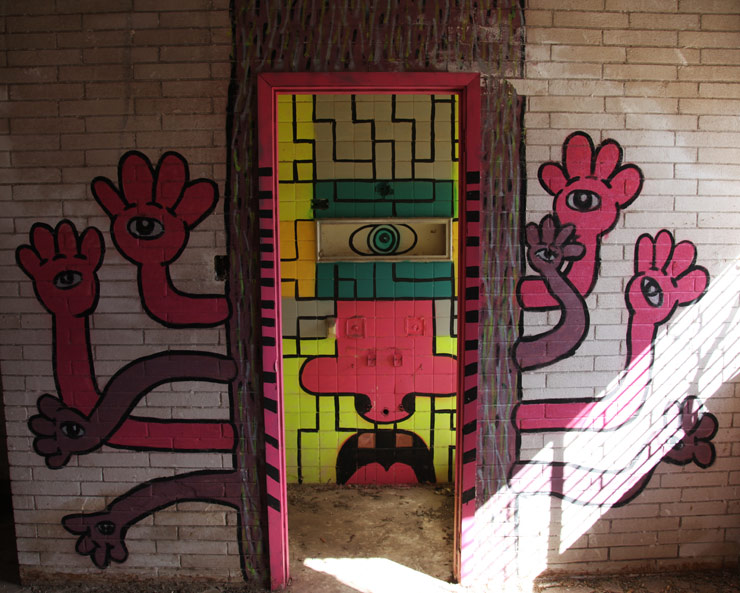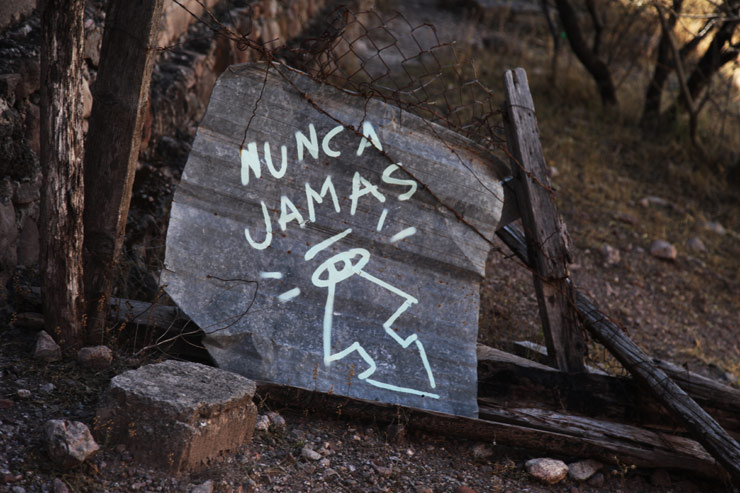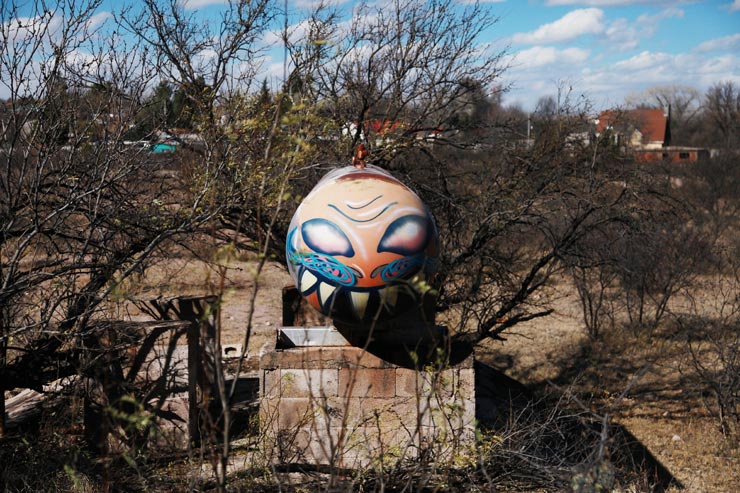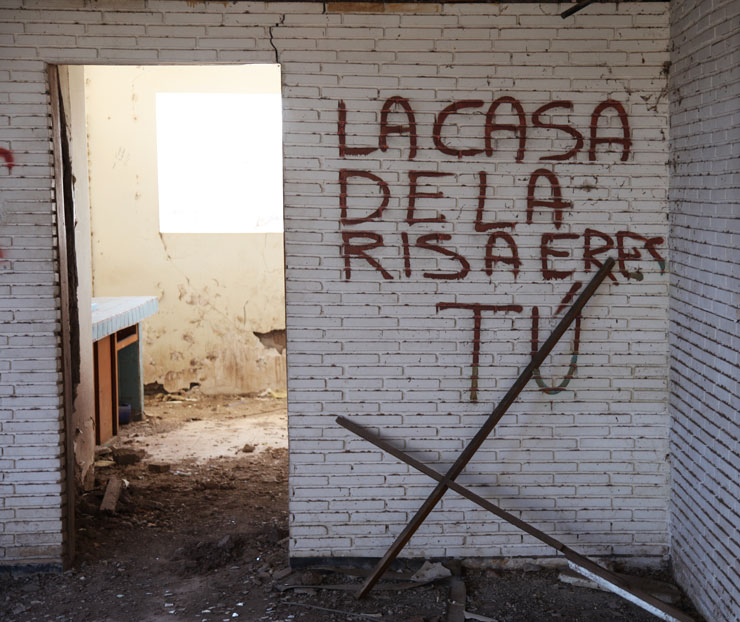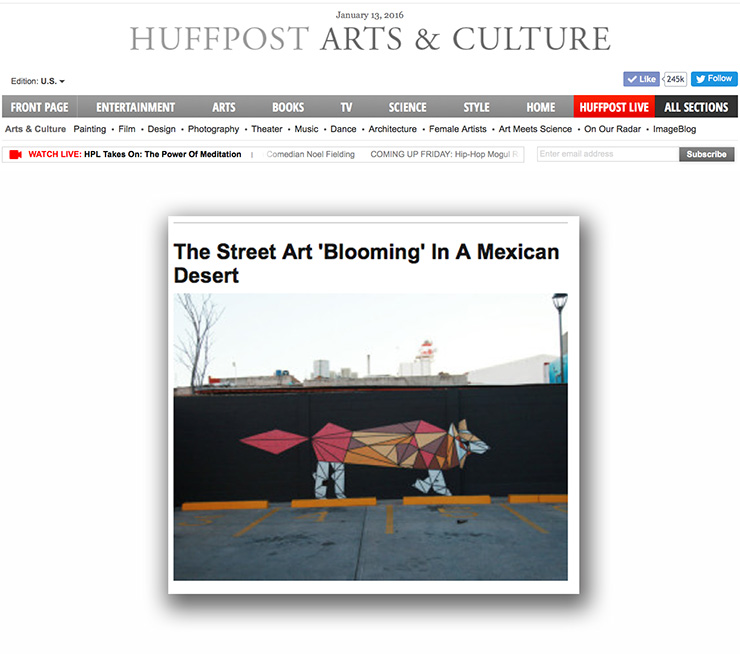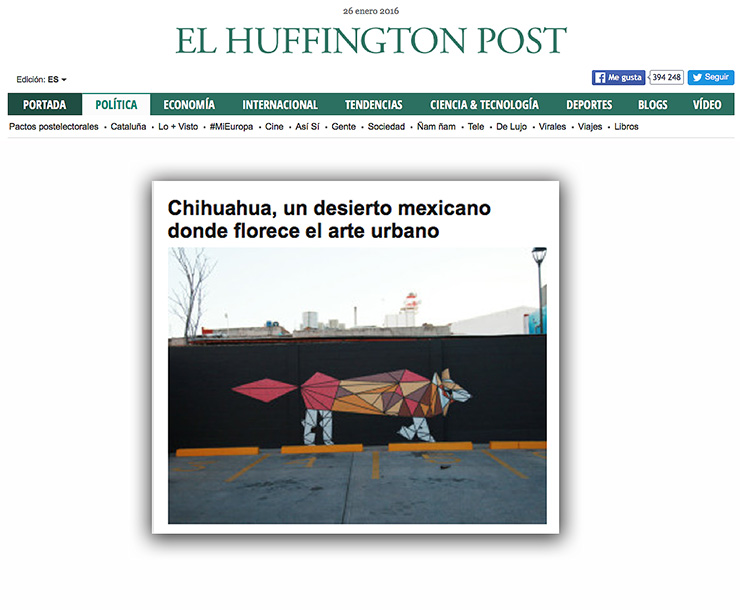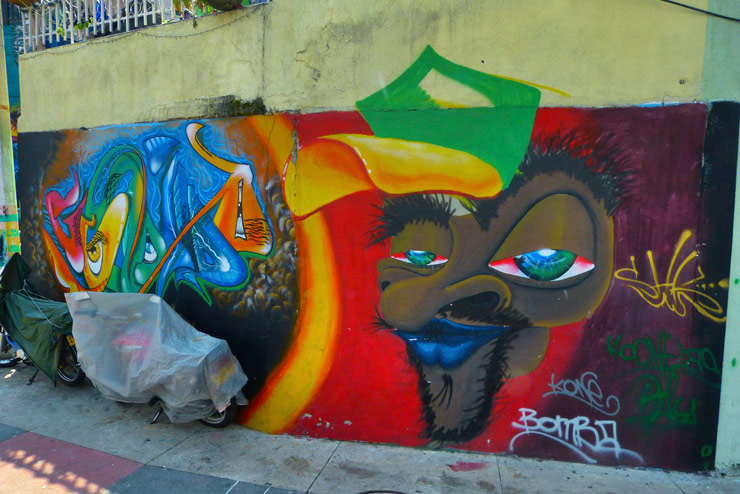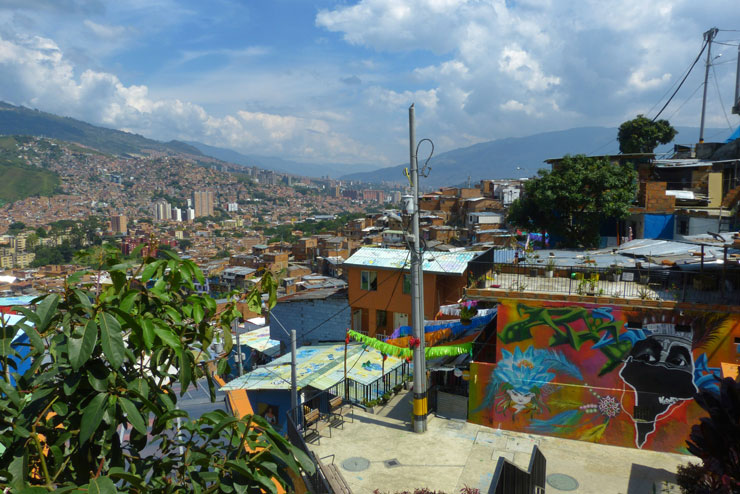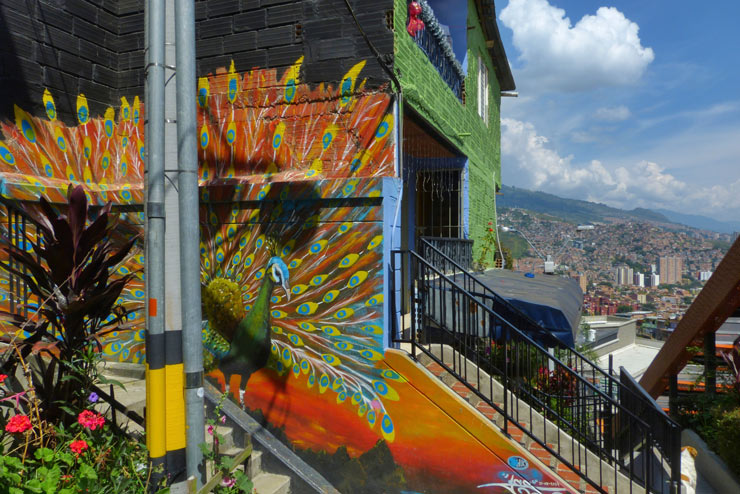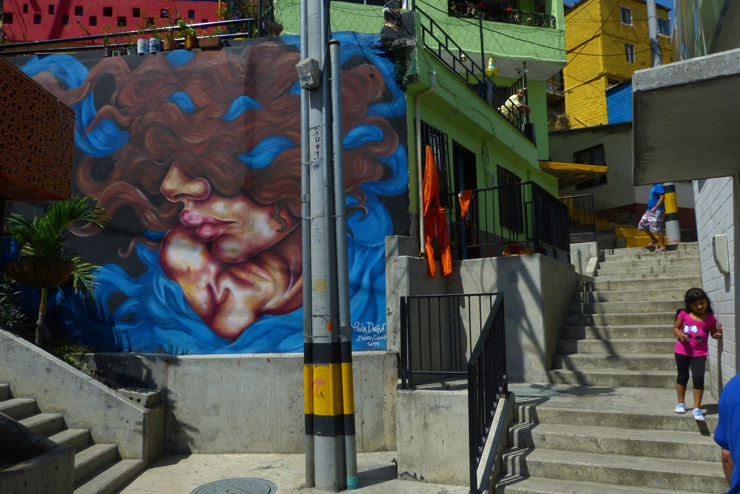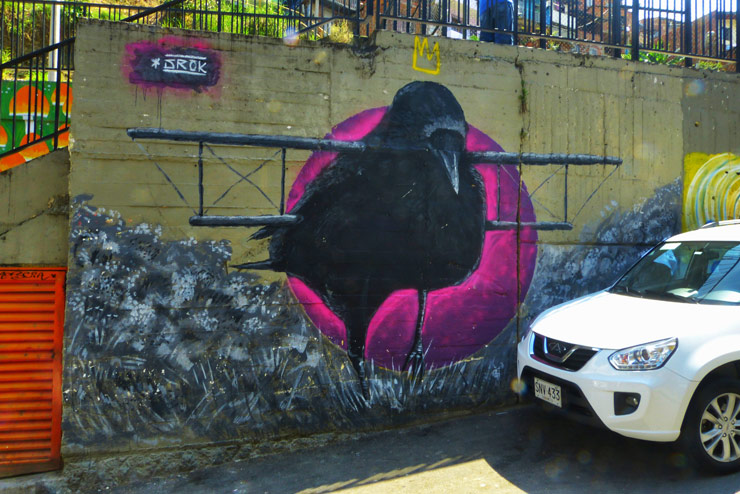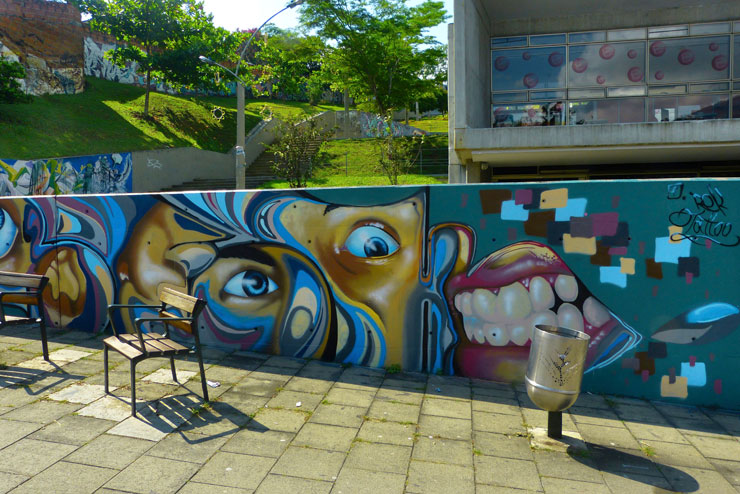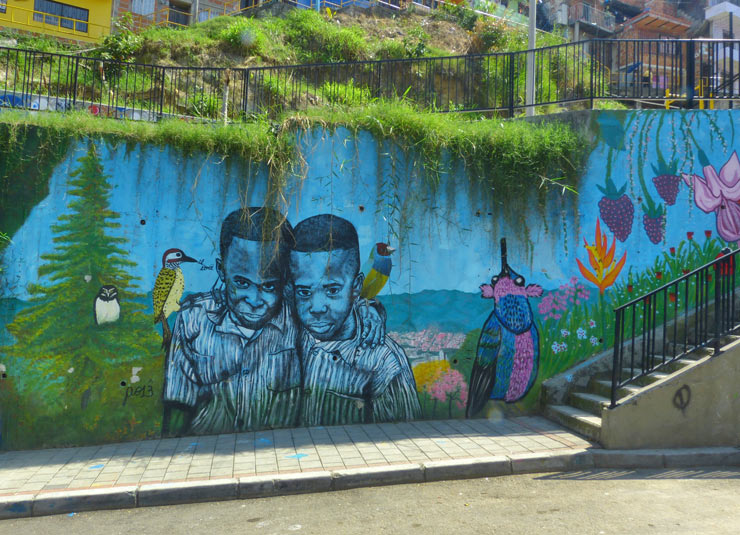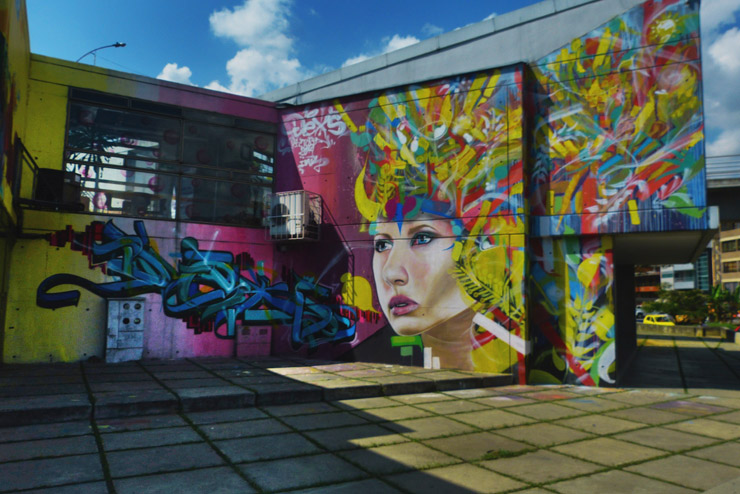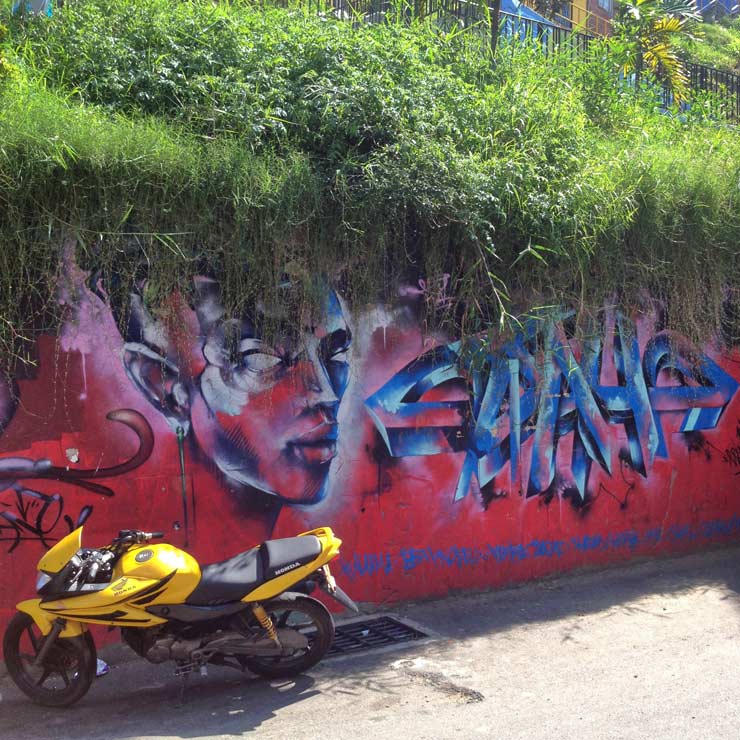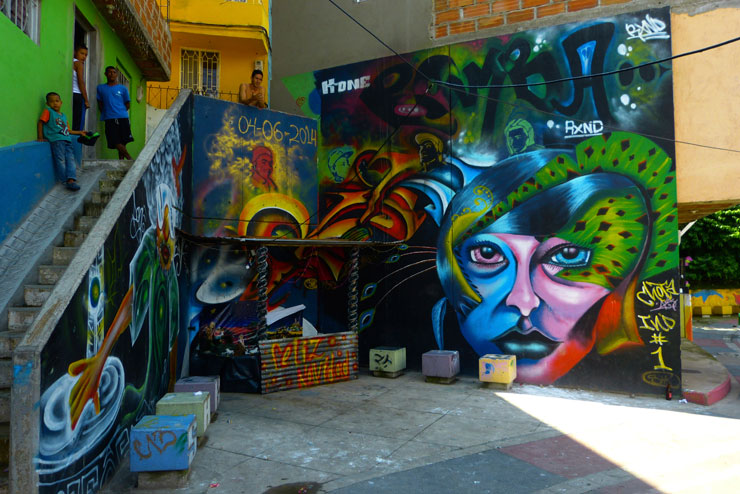“Chihuahua is like one big ranch,” says a local reporter who guides you around this desert city known for beef, cheese, sotol, cowboy boots… and a growing middle class – thanks to the hundred plus multinational maquiladoras operating here with a focus on aerospace, medical equipment, and automobile manufacturing.
The “ranch” metaphor is meant to be welcoming, but it also lets you know that this city of nearly a million can still feel like a small town. This is the capital of Mexico’s largest state, which goes by the same name. And yes, the diminutive and scrappy dog originated here – as did Pancho Villa, and you can visit his homestead if you like.
It’s not the typical city where you might expect to find Street Art, yet only a few blocks from the government palace downtown that holds two stories of wall paintings by Mexican muralist Aarón Piña Mora, you will find new paintings in the dusty side streets that indicate a more international flavor is present.
Paola Delfin. Chihuahua, Mexico. Centropolis Art Festival 2014. (photo © Jaime Rojo)
Largely conservative by most accounts, Chihuahua city in the twenty-teens has been sampling the flavors of the burgeoning global Street Art scene thanks two locally organized arts festivals; Ruta in 2013 and Centrópolis in 2014, and to the stylistic adventuring of local artists on other walls outside these approved ones.
Paola Delfin. Chihuahua, Mexico. Centropolis Art Festival 2014. (photo © Jaime Rojo)
Local custom has been to dismiss those un-permissioned painters as cholos, a disparaging term referring to a criminal element. Today its not as simple to disparage this rising tide of painters in the streets when cities across Europe and the US are actually seeking out and inviting Street Artists and muralists to come and revitalize a neighborhood or draw youth into a city center.
“Street Art has traditionally been seen as a form of vandalism but thanks to the festivals that include visual artists as the special guest it is slowly changing the way people see graffiti and street art,” explains Ivonne Dalila Miramontes, a curator and photographer who studied in the Arts Faculty of the Universidad Autónoma de Chihuahua, and who currently teaches visual arts to high school students.
Paola Delfin. Chihuahua, Mexico. Centropolis Art Festival 2014. (photo © Jaime Rojo)
“It’s a subtle distinction but it’s a big deal, because now the new murals have a meaning and people don’t see art in the streets anymore strictly as vandalism and it has been a great opportunity for local artist to express themselves and be recognized as artists.”
You’ll see tagging on abandoned walls in some neighborhoods, and there is a range of old-school graffiti styles represented along with political ads for candidates and commercial ads for muffler repair shops on the low flung long walls that run alongside some carreteras in Chihuahua.
You’ll also see uncommissioned paintings that are figurative, or minimally abstract, or have a more trained illustrators eye here and there. Suddenly it looks like there is a small mushrooming of art on the streets. Is it a movement, a sign of a future renaissance of arts and culture, as we have seen in many international cities, or is it a chance outcropping that will be stomped out or left to die in the sun?
Adán Estrada AKA El Disko. Chihuahua, Mexico. (photo © Jaime Rojo)
“It is really great to be able to do my work in different cities,” says Paola Delfin, one of the new breed of Mexican Street Artists who has travelled to festivals internationally at the invitation of organizers in Miami, Puerto Rico, Brazil, even Berlin.
“I like to observe the impact that this work has on the people and on the environment in each of them. Coming from Mexico City where art, specifically muralism, has an important history, it’s always interesting and inspiring to work in new places. Some cities like Berlin also have a huge background of art, muralism or street art, so people are more accustomed to this work.”
HidroC. Chihuahua, Mexico. (photo © Jaime Rojo)
Delfin’s own female-centric paintings here were completed during the Centrópolis festival – one with undulating wavelike hair that envelops the monochromatic figure on a partially decayed wall. The other painting uses a more realist technique she is experimenting with; levitating above the street perhaps to recall the magic realism famous in Latin literature by writers like the celebrated Colombian Gabriel Garcia Marquez, who wrote many of his greatest works while living in Mexico City for decades.
“’Susana’, the levitating modern girl, is a based on a girl I met during the festival,” Delfin says, “She was helping all the artists there and she helped me a lot – and I like to paint people who had some impact in my life somehow, and I asked here if I could use her as a model.”
Serene and still, the artist says the figure is meant to allude to a dangerous trade that has claimed many young women closer to the border four hours north of here.“I painted ‘Susana’ sleeping. She is waiting to wake up and find some peace surrounding her. For me she represents the young women up there.” Of course some of the works touch on societal themes, and others can have political undertones.
CRON. Chihuahua, Mexico. Centropolis Art Festival 2014. (photo © Jaime Rojo)
For Bebo, a Mexican artist who has created many of his trademark foxes as stencils and abtract linear forms on walls throughout cities south and north of the border, his work is allegorical – although most passersby won’t necessarily know how strong his intent is. “I use mostly foxes on my work. I think foxes’ faces show how diverse they are physically as specimens but I also like their character – playful and mythical at the same time. ”
“My work can’t ignore this absurd political reality we are in. It feels like the whole of Mexico is a battle ground,” he says as he talks about the five paintings he did in Chihuahua city in 2014. “My work can’t reflect this reality but instead wants to change it. It is a small step to do something. My approach is entirely metaphysical. To fight against the ignorance I use my imagination. To fight against terror I use hope. I like to offer a different path.”
Eldeini. Chihuahua, Mexico. Centropolis Art Festival 2014. (photo © Jaime Rojo)
His path to Chihuahua was lead by Felix Lugo, a local artist and independent curator who organized the Street Artists with the Centrópolis festival, which included three days music stages, theatre, traditional cultural events, and according to organizers, close to 100,000 people. Although not all of that foot traffic was here to see the murals, he thinks that a painting is often better than a blank wall.
“I paint to open a dialogue on the streets,” says Bebo, “It is like a window to establish change in a specific city and at the same time to connect people with each other.”
Ovrlnds and DISKO. Chihuahua, Mexico. Centropolis Art Festival 2014. (photo © Jaime Rojo)
For now, we offer you these images of a few remaining pieces and some brand new ones that were discovered around the city, as well as an abandoned spot north of the metropolis where you’ll find more typical graffiti artists trying their hand at the spray can.
Who knows if this warm and dry city can support the new generation of creative voices that are now being called on in many cities globally to create excitement and engage art fans, but we did see a few cafes and even a gallery or two where this art has been springing up.
Ovrlnds and Disko. Chihuahua, Mexico. Centropolis Art Festival 2014. (photo © Jaime Rojo)
“I do see a future for a large Street Art/mural festival,” says Miramontes, who notes that local artists were energized by the attention that the plastic arts were receiving.
“It made me feel that art is being taken seriously in my city. Also the murals are the only things that still remain after all the festivals, and when I pass by any of the artworks I remember being around while the artists were working and seeing friends, families and people in general having fun enjoying this form of art. We just need more people interested and involved in this environment so we can achieve success by bringing this kind of art to the community.”
Mil Amores. Chihuahua, Mexico. Centropolis Art Festival 2014. (photo © Jaime Rojo)
Mil Amores. Chihuahua, Mexico. Centropolis Art Festival 2014. (photo © Jaime Rojo)
Jelly Fish. Detail. Chihuahua, Mexico. Centropolis Art Festival 2014. (photo © Jaime Rojo)
Jelly Fish. Chihuahua, Mexico. Centropolis Art Festival 2014. (photo © Jaime Rojo)
Mil Amores. Chihuahua, Mexico. Centropolis Art Festival 2014. (photo © Jaime Rojo)
CAM. Chihuahua, Mexico. Centropolis Art Festival 2014. (photo © Jaime Rojo)
Mil Amores. Chihuahua, Mexico. Centropolis Art Festival 2014. (photo © Jaime Rojo)
Mil Amores. Chihuahua, Mexico. Centropolis Art Festival 2014. (photo © Jaime Rojo)
Chihuahua, Mexico. (photo © Jaime Rojo)
Clasicco. Chihuahua, Mexico. (photo © Jaime Rojo)
BEBO. Chihuahua, Mexico. Centropolis Art Festival 2014. (photo © Jaime Rojo)
BEBO. Chihuahua, Mexico. Centropolis Art Festival 2014. (photo © Jaime Rojo)
BEBO. Chihuahua, Mexico. Centropolis Art Festival 2014. (photo © Jaime Rojo)
BEBO. Chihuahua, Mexico. Centropolis Art Festival 2014. (photo © Jaime Rojo)
BEBO. Detail. Chihuahua, Mexico. Centropolis Art Festival 2014. (photo © Jaime Rojo)
BEBO. Chihuahua, Mexico. Centropolis Art Festival 2014. (photo © Jaime Rojo)
BEBO. Santa Isabel. Chihuahua, Mexico. (photo © Jaime Rojo)
Artist Unknown. Santa Isabel. Chihuahua, Mexico. (photo © Jaime Rojo)
Artist Unknown. Santa Isabel. Chihuahua, Mexico. (photo © Jaime Rojo)
Artist Unknown. Santa Isabel. Chihuahua, Mexico. (photo © Jaime Rojo)
Mil Amores. Santa Isabel. Chihuahua, Mexico. (photo © Jaime Rojo)
<<>>><><<>BSA<<>>><<<>><><<>>><><<>BSA<<>>><<<>><><<>>><>
Please note: All content including images and text are © BrooklynStreetArt.com, unless otherwise noted. We like sharing BSA content for non-commercial purposes as long as you credit the photographer(s) and BSA, include a link to the original article URL and do not remove the photographer’s name from the .jpg file. Otherwise, please refrain from re-posting. Thanks!
<<>>><><<>BSA<<>>><<<>><><<>>><><<>BSA<<>>><<<>><><<>>><>
This article is also published on The Huffington Post.
This article is also published on El Huffington Post.
 BROOKLYN STREET ART LOVES YOU MORE EVERY DAY
BROOKLYN STREET ART LOVES YOU MORE EVERY DAY